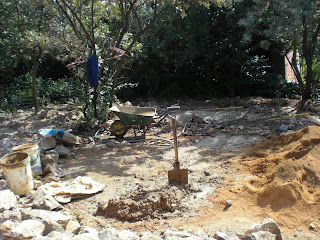‘I appreciate the misunderstanding I have with nature over my perennial border. I think it is a flower garden, she thinks it is a medow lacking grass, and tries to correct the error. ‘ Sara Stein
There is such a misconception when it comes to our indigenous beauties. The image that seems to come to people’s minds when you mention indigenous is succulents and veld grasses with a rather dull colour pallet. How far from the truth this is we have a whole range of plants for every colour in the colour wheel the choice is huge. Not only do we have the choice of any colour we want ,but many plants have so many characteristics not only do they have beautiful flowers but they are scented and attract butterflies and birds, not many of our exotic species can boast about having all these attributes.
No matter where you garden is and the soil type you have there is a plant for every space. Hot and dry our aloes take pride of place giving an awe-inspiring sight on those winter days when not much else is in flower. These beautiful focal plants are used in many contemporary designs because of their amazing architectural beauty. Pair these up with soft grasses and groupings of succulents you will create a very contemporary design. That will not only be water wise, modern and low maintenance but you will also encourage the humming birds and bees into your garden.
A plant that all are familiar with is the Agapanthus we see them planted in mass all over South Africa. Seen on our road island plantings and in just about every garden there is at least one or two tucked away somewhere. These hardy beauties grow in any almost any soil condition sun or shade giving a continuous show of colour during our festive season. We now have a spectacular selection of hybridised Agapanthus to choose from. An amazing display can be achieved by mixing all the different colours. Paired with Zantedeschia aethiopica and a selection of plectranthus you will have an informal mix of beauties that will brighten up any shady area of your garden.
When it comes to our trees we really don’t use half the selection we have. Many of our gardens have become smaller and it becomes an extremely important decision when it comes to the choice of tree. Trees are forever, they are the one element in your garden that can’t be moved around or changed. So many people plant trees that become to big for their garden not only does the scale look wrong but it becomes an ongoing maintenance battle of taking off branches that are blocking out the sun or growing into walls. Big trees generally mean big roots causing havoc with plumbing and foundations resulting in the tree fellers paying a visit and the tree being removed. All this can be avoided with a bit of research and thought. Trees should be planted a minimum of one meter away from boundary walls and five meters form any building. What would you like your tree to do for you? Screen off the nosy neighbours and create some shade then an evergreen tree would be the best choice. I like using either the Rhus lancea or Rhus pendulina, as they are fast growing, heat, drought resistant, with a non-aggressive root system as well as attracting both birds and butterflies into the garden. If you want seasonal interest then deciduous trees mark out the change of seasons with grace, their leaves changing colour in the fall and dropping during winter so the sun can warm your garden, with the branches silhouetted against the crisp wintry sky.
If you want to find out more about brining nature back into your garden I recommend you buy Bring Nature back to your garden by Charles and Julia Botha.






















